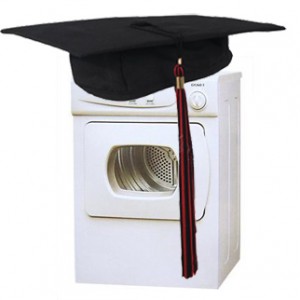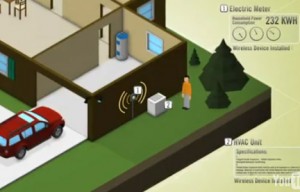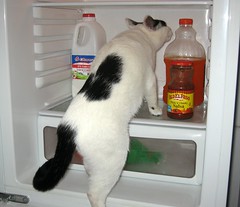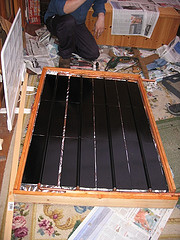One of the coolest things about Thanksgiving? Unlike Halloween, it’s not about stuff. While Halloween wouldn’t be the same without candy, costumes, and décor, Thanksgiving celebrates giving thanks for what you already have. What a relief for your pocketbook and the planet. —treehugger
Category Archives: Home
Cambridge residents cut carbon as part of International Day of Climate Action

Area 4 Light Bulb Exchange
On October 24th, volunteers worked with the Home Energy Efficiency Team (HEET) and the Cambridge Energy Alliance to weatherize Cambridge buildings and provide efficient light bulbs and resources to Area 4 residents as part of the International Day of Climate Action. This local grassroots effort was part of 4,000 world-wide groups that demonstrated their commitment to fighting climate change by rallying in big cities and engaging in creative community actions. The International Day of Climate Action is called on world leaders to commit to bringing carbon emissions down from its current 387ppm to a safe level of 350 or less.

Women's Center Barnraising
Over seventy volunteers came together to weatherize both the Women’s Center and the Wendell Street coop through air sealing improvements to the windows, doors, and gaps in the basement, plus other efficiency measures like installing compact fluorescent light bulbs. The communities of Reading, Boston, Waltham, Arlington, and Maynard will continue the spirit of the International Day of Action with weatherization barnraisings scheduled for the next 30 days. The buildings included homes for mentally disabled adults and a church.
The HEET team also collaborated with the Cambridge Energy Alliance to help Area 4 residents save energy and cut carbon by exchanging incandescent light bulbs for compact fluorescents. The light bulb exchange was a huge success; saving Area 4 residents over 29,000 pounds of carbon per year by replacing 346 incandescent light bulbs. In addition, the Cambridge Energy Alliance completed its fall canvass in other Cambridge neighborhoods that day by exchanging 579 cfl lightbulbs, saving an additional 341,378 lbs of carbon. These outreach activities also provided energy effiency resources to help families start saving money, plus connect them to energy effiency programs for their homes or businesses.
Many of the Cambridge volunteers ended the day by joining the Boston 350 Under Water Festival. Hundreds of citizens gathered en masse in downtown Boston’s Christopher Columbus Park and engaged in positive attention-getting and imagination-catching activities. The Boston 350 event used the iconic image of sea level rise to draw attention to the threat of global climate change.
The International Day of Action reflected the famed mantra “Think global and act local”! There are a number of ways to get involved in sustainability, energy, and climate activities which can be found on the Cambridge Energy Alliance calendar. To get involved in the Home Energy Efficency barnraising events visit there website at heetma.com/.
Jackfrost nipping at your nose
 Although you could be forgiven for wondering if we even had a summer, it’s clear winter’s just around the corner. Here are some ideas to help you prepare:
Although you could be forgiven for wondering if we even had a summer, it’s clear winter’s just around the corner. Here are some ideas to help you prepare:
- Eat spicy food
- Drink warm beverages
- Use body heat instead of central heating: cuddle
- Wear socks/slippers: warm tootsies = warm feelings
For other, more pragmatic tips, see the CEA website.
Smart Grid = Smart Appliances
 Yesterday’s New York Times carried an article about appliance maker Whirlpool, who was the recipient of a $20 million grant from the Federal Government to fund product development in the rapidly developing field of smart appliances.
Yesterday’s New York Times carried an article about appliance maker Whirlpool, who was the recipient of a $20 million grant from the Federal Government to fund product development in the rapidly developing field of smart appliances.
These devices, once connected to a Smart Grid-enabled electricity supply, will be able to receive information from the grid and cycle down their power demands during times of peak energy use (and higher costs per kWh). At the moment, they are anticipating savings of $40 per year for a standard size dryer.
As always, your mileage may vary.
Next in the Smart Grid appliance pipeline, General Electric Co. will soon roll out its first commercial smart appliance, a hybrid electric heat pump water heater. The company said the pump will save consumers $250 a year in energy costs.
Other “demand response” appliances expected within the next year are refrigerators able to delay defrost cycles and dishwashers that delay operation until energy demands and costs decline at night.
The Federal Energy Regulatory Commission estimates smart grid-enhanced home appliances could shave up to 7 percent off U.S. peak demand through 2019. When this is added to the 15% reduction in demand that Smart Grid monitoring devices have been able to achieve in field testing, we have within our grasp the ability to reduce electricity consumption by 20% without making any structural changes within our homes.
DIY Solar Power
Now that winter’s just around the corner, though you might be hard-pressed to believe it with how fickle Mother Nature’ been of late, you’re probably starting to dread the heating bills that accompany it. But just because it’s getting cold doesn’t mean you cannot take advantage of free energy from the sun.
For most of us, it’s probably too late to orient our homes so most windows are on the southern face, or plant deciduous trees on the same side of the house, and evergreens on the windward.1 But there are still plenty of ways to take advantage of this underused resourced, not the least of which is leaving your curtains open during the day, especially if you have modern, low-emissivity (“low-e”), insulated windows.
Another interesting way to use the sun is through solar thermal technologies. Although these systems typically garner less attention than photovoltaics, they can work quite well at our latitude, either as a space or water heater. Commercial systems such as these solar hot air panels are actually quite economical at approximately $1,500, but it’s also possible to build your own. There are a number of plans available online, of varying complexity, from soda cans & spray paint to sloping window-mounted affairs. With a one-square-yard device you could provide as much heat as an electric baseboard or portable heater.23
1. The deciduous trees shield the windows from intense solar exposure in the summer, but permit light to enter the home once the drop their leaves in fall. The conifers remain bushy year-round, acting as a windbreak and thereby reducing heat loss.
3. A simple but imperfect test to determine if a sheet of acrylic will let some of your captured sunshine escape is to see if a remote will work behind it. If the remote does not work, then the sheet blocks infrared, which is what you want.
Results from the Smart Grid
 For the last six months, IBM has been running a Smart Grid test in the town of Fayettevile, North Carolina. First results show the average Smart Grid home reduces their energy usage by a surprising 15%.
For the last six months, IBM has been running a Smart Grid test in the town of Fayettevile, North Carolina. First results show the average Smart Grid home reduces their energy usage by a surprising 15%.
The reasons offered start with the companies involved (IBM & Consent) who claim; “If it can be measured, it can be managed.” This concept has been around for a number of years, but it needs further detail to understand exactly why they called it the Smart Grid and why it could be the Holy Grail of energy efficiency.
Each house on the Smart Grid gives owners the ability to set daily use profiles, check real-time energy consumption, create monthly bill targets and cycle off appliances during peak load times–all through a standard Internet connection. One of the things the Smart Grid allows you to see–and correct–is the surprising amount of ‘vampire power’ a house consumes. Your computers, air conditioners, HDTVs, and water heater all use energy even when they’re switched off. By either unplugging these devices or cycling down power supply when you are not in the house or asleep, you can immediately cut your electricity use by least 10%.
Of course, you don’t need to wait for your local utility or IBM to put you on the Smart Grid before you start reducing your energy bills and saving money. For the first day of fall, here’s some tips for winterizing your home. And some low/no cost steps you can take for year-round energy efficiency.
Dollars 4 Dishwashers
There were a number of issues with the “Cash for Clunkers” program, including excessive paperwork and bureaucracy, poor planning, etc. Even though the program was touted as having environmental benefits, and not merely another handout to big business, there were questions as to the significance of these impacts before the program ended. Soon there will be another rebate program, which has thus far received little attention, and has apparently been dubbed by some “Dollars for Dishwashers” to disparage it. The outcome of this enery star appliance rebate “program” will be more interesting to watch since each state is responsible for developing a plan to disperse its awarded funds. Massachusetts was awarded $6 million by the DoE, and rebates should become available in 4 to 6 weeks. Keep your eyes open, and get ready to build a super-efficient fridge… I know I’ll be bugging my landlord soon enough.
Greening Living According to No Imapct Man
 Spending three days in a meditation retreat center in western Massachusetts for labor day weekend reminded me how complex and busy my life has become in the hustle and bustle of Boston. It is easy being green out in the woods, where you are not tempted by the daily conveniences of fancy coffees, take out foods, and the countless other goodies to consume at ones whim. On a number of occasions I have lived in the countryside practicing permaculture and other eco-techniques like raising chickens, vermiculture, and biking as my sole mode of transportation. While these options are available here in Boston, finding the time to fully practice being green is an incredible challenge.
Spending three days in a meditation retreat center in western Massachusetts for labor day weekend reminded me how complex and busy my life has become in the hustle and bustle of Boston. It is easy being green out in the woods, where you are not tempted by the daily conveniences of fancy coffees, take out foods, and the countless other goodies to consume at ones whim. On a number of occasions I have lived in the countryside practicing permaculture and other eco-techniques like raising chickens, vermiculture, and biking as my sole mode of transportation. While these options are available here in Boston, finding the time to fully practice being green is an incredible challenge.
Collin Beavan, also known as No Impact Man, decided to try living impact free for one year in Manhattan with his family and their story is being released on September 11th to raise awareness on how to live more sustainable lives. The documentary trailer highlights some of the difficulties and rewards of living more sustainably and challenges individuals to look at what they eat, consume, drive, and all the other modern conveniences that have a collective impact on the planet. For instance, Colin Beavan’s wife Michelle struggled with giving up her Starbuck coffee’s but ended up reversing her diabetes through adopting a healthy diet and walking 24 flights of stairs instead of taking the elevator. The family initially mourned the loss of their television and other conveniences but ended up finding more quality time for each other. Check out No Imapct Man’s tips on how to live green and the savings they made over the course of their project.
The Carbon footprint of computers
 A lot of attention has been paid to the carbon footprint of automobiles, airplanes, and buildings, but one of the activities that takes up most of our time has gotten little attention: computers. In a recent article in the Economist, they covered a report published by the Climate Group on the climate impacts of computers. Surprisingly, computers have a cumulative impact similar to that of air travel, producing approximately 830 million
A lot of attention has been paid to the carbon footprint of automobiles, airplanes, and buildings, but one of the activities that takes up most of our time has gotten little attention: computers. In a recent article in the Economist, they covered a report published by the Climate Group on the climate impacts of computers. Surprisingly, computers have a cumulative impact similar to that of air travel, producing approximately 830 million
On the bright side, computers can offer a number carbon cutting tools like smart meters. Savings also can be obtained by businesses using distributive computing, instead of running their own server. An example of energy saving opportunities, was posted in the E2.0 article, ” Holyoke Green Data Center“, which would serve as a resource for multiple universities involved in biotechnology and climate industries.
As an individual, you can reduce the carbon footprint of your computer and its complementary accessories like, printers, faxes, and cell phones. The following tips can help you trim carbon calories from your energy waist line:
- Unplug all your computers and complimentary machines. Even in the off or sleep mode they pull energy from the grid, often referred to as vampire loads!
- Set your computer to sleep mode when you are away from your desk for prolonged periods of time (15 minutes or more)
- Purchase an energy efficient PC. Laptops actually use a lot less energy than desktops.
- Turn off your computer when you are done for the day and use a power strip so that you can turn off all computer accessories at once.
Cooler coolers
 Having a tough time getting you or your loved ones to not stand in front of the fridge with the door open? While behavioral changes are almost always the cheapest and most efficient means of reducing consumption, there are some interesting technical solutions available in this area. You could try installing a curtain (opting for the thinner Mylar/polyester over PVC), or purchasing a chest refrigerator. This little known refrigerator format has the advantage of keeping the cool air inside (it sinks and stays trapped) while also providing a secondary work surface in a crowded kitchen.
Having a tough time getting you or your loved ones to not stand in front of the fridge with the door open? While behavioral changes are almost always the cheapest and most efficient means of reducing consumption, there are some interesting technical solutions available in this area. You could try installing a curtain (opting for the thinner Mylar/polyester over PVC), or purchasing a chest refrigerator. This little known refrigerator format has the advantage of keeping the cool air inside (it sinks and stays trapped) while also providing a secondary work surface in a crowded kitchen.
New fridge not in the budget? Well, you might be interested in this oldie but goodie which has recently sprung up again: “convert” a chest freezer into a chest refrigerator for about $60. Your custom fridge could end up running a whole year for the cost of one month of power for a typical refrigerator! (140 kWh/yr reported energy use, vs. 144 kWh/mo energy use for 17.5 ft3 frostless refrigerator/freezer) Of course, one disadvantage to this format is that you’ll need a separate freezer, but you should still end up far ahead.

